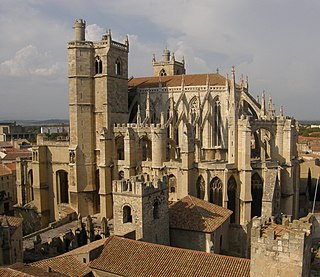Contents
| |||||
| Decades: | |||||
|---|---|---|---|---|---|
| See also: | Other events of 1510 History of France • Timeline • Years | ||||
List of events from the year 1510 in France.
| |||||
| Decades: | |||||
|---|---|---|---|---|---|
| See also: | Other events of 1510 History of France • Timeline • Years | ||||
List of events from the year 1510 in France.


The Archdiocese of St. Louis is a Latin Church ecclesiastical territory, or archdiocese, of the Catholic Church in the eastern part of the U.S. state of Missouri.

The Archdiocese of Chicago is a Latin Church ecclesiastical jurisdiction, an archdiocese of the Roman Catholic Church located in Northeastern Illinois, in the United States. The Vatican erected it as a diocese in 1843 and elevated it to an archdiocese in 1880. Chicago is the see city for the archdiocese.

The Roman Catholic Diocese of Condom was a French bishopric based in Condom from 1317 to 1801.

Georges d'Amboise was a French Roman Catholic cardinal and minister of state. He belonged to the house of Amboise, a noble family possessed of considerable influence: of his nine brothers, four were bishops. His father, Pierre d'Amboise, seigneur de Chaumont, was chamberlain to Charles VII and Louis XI and ambassador at Rome. Georges' eldest brother, Charles, was governor of the Île-de-France, Champagne and Burgundy, and councillor of Louis XI.

The Archdiocese of Rouen is a Latin Church archdiocese of the Catholic Church in France. As one of the fifteen Archbishops of France, the Archbishop of Rouen's ecclesiastical province comprises the greater part of Normandy. The Archbishop of Rouen is currently Dominique Lebrun.

The Diocese of Périgueux and Sarlat is a Latin Church ecclesiastical territory or diocese of the Catholic Church in France. Its episcopal see is Périgueux, in the département of Dordogne, in the région of Aquitaine. The Diocese of Périgueux is a suffragan diocese in the ecclesiastical province of the metropolitan Archdiocese of Bordeaux. The current bishop is Philippe Mousset, who was appointed in 2014.

The Diocese of Tarbes et Lourdes is a Latin Church ecclesiastical territory or diocese of the Catholic Church in France. Until 2002 Tarbes was a suffragan of the Archdiocese of Auch. It is now a suffragan of the Archdiocese of Toulouse.

François Guillaume de Castelnau de Clermont-Lodève (1480–1541) was a French diplomat and Cardinal. He was the son of Pierre-Tristan, Seigneur de Clermont et de Clermont-Lodève and Vicomte de Nébouzan, and Catherine d'Amboise. His father was a member of the Order of Saint Michael. François' grandmother had been heiress of Dieudonné Guillaume de Clermont. He had an elder brother, Pierre de Castelnau, who was heir to the family estates. François was also the nephew of Cardinal Georges d'Amboise (1498-1510), who was largely responsible for François' swift rise to prominence in the Church. Cardinal d'Amboise had been Archbishop of Narbonne from 1491 to 1494.

The former Catholic diocese of Narbonne existed from early Christian times until the French Revolution. It was an archdiocese, with its see at Narbonne, from the year 445, and its influence ran over much of south-western France and into Catalonia.

Guillaume Briçonnet (1445–1514) was a French cardinal and statesman.

Pierre d'Amboise was a French nobleman of the House of Amboise. He was a son of Hugh VIII of Amboise, who was killed at the battle of Agincourt, and of Jeanne de Guénand.
Louis de Bourbon-Vendôme, was the son of Francis, Count of Vendôme and Marie of Luxembourg and a French prince du sang and religious leader.
René de Prie (1451–1519) was a French Roman Catholic bishop and cardinal.
Louis d'Amboise was a French Roman Catholic bishop and cardinal.
Events from the year 1566 in France.
Events from the year 1581 in France
Events from the year 1514 in France.

In 1510, an acute respiratory disease emerged in Asia before spreading through North Africa and Europe during the first chronicled, inter-regional flu pandemic generally recognized by medical historians and epidemiologists. Influenza-like illnesses had been documented in Europe since at least Charlemagne, with 1357's outbreak the first to be called influenza, but the 1510 flu pandemic is the first to be pathologically described following communication advances brought about by the printing press. Flu became more widely referred to as coqueluche and coccolucio in France and Sicily during this pandemic, variations of which became the most popular names for flu in early modern Europe. The pandemic caused significant disruption in government, church, and society with near-universal infection and a mortality rate of around 1%.
Events from the year 1508 in France
Events from the year 1507 in France